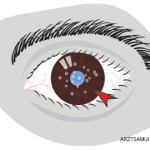 Whether the infection is obvious or not, ophthalmologists have long suspected that uveitis is triggered by an infectious organism. The process behind the initiation of the disease process, however, has remained obscured by a lack of knowledge about the early inflammatory signals. Now, researchers say a receptor of the innate immune system, the C-type lectin receptor (CLR) mincle, is a critical player in the induction of experimental autoimmune uveoretinitis (EAU). The identification of mincle may be particularly satisfying because mincle expression has previously been implicated in the susceptibility to mycobacterial and fungal infections. The new research, thus, takes the traditional understanding of autoimmune uveitis as a T cell-dependent model of EAU into new territory.
Whether the infection is obvious or not, ophthalmologists have long suspected that uveitis is triggered by an infectious organism. The process behind the initiation of the disease process, however, has remained obscured by a lack of knowledge about the early inflammatory signals. Now, researchers say a receptor of the innate immune system, the C-type lectin receptor (CLR) mincle, is a critical player in the induction of experimental autoimmune uveoretinitis (EAU). The identification of mincle may be particularly satisfying because mincle expression has previously been implicated in the susceptibility to mycobacterial and fungal infections. The new research, thus, takes the traditional understanding of autoimmune uveitis as a T cell-dependent model of EAU into new territory.
Ellen J. Lee, OD, PhD, a research assistant professor of ophthalmology at the Oregon Health and Science University in Portland, and colleagues published the results of their study of the pathogenesis of uveitis in the April 1 issue of the Journal of Immunology. The investigators used knockout mice to tease apart the receptors responsible for the induction of EAU. They began their study by focusing on the caspase-associated recruitment domain adaptor 9 (Card9) protein, which mincle uses for signaling.
The researchers attempted to induce EAU via immunization of wild type and Card9 knockout mice with the interphotoreceptor retinoid binding protein (IRBP). They found the immunized Card9 knockout mice had a diminished proportion of CD4+ cells in the eye when compared with the wild type mice. Specifically, they noted that the lack of EAU in Card9 knockout mice correlated with a decreased ratio of IRBP-specific Th17 vs. IRBP-specific Th1 cells. They explained this finding by documenting that Card9 regulates IRBP-specific production of IL-17A.
Further investigation revealed that, in addition to differences in IRBP-specific T cells, vaccinated Card9 knockout mice had reduced Th1 and Th17 populations in their eyes relative to vaccinated wild type mice. The Card9 knockout mice did, however, have an intact peripheral-associated Th1 response. The authors proposed that this difference was the result of altered T cell trafficking mechanisms. The team concluded from these experiments that Card9 is required for the inflammatory pathway leading to EAU and that Card9 has the ability to influence the development of Th1 vs. Th17 T cell effector responses in EAU.
The researchers next turned their attention to the early/acute phase of the ocular inflammatory response. They found this phase of the response reflected the Card9 transcriptional profile in the retina. Moreover, activation of the proximal CLR mincle appeared to initiate the induction of EAU. The investigators confirmed this with mincle knockout mice, which they found to have decreased severity of EAU relative to wild type mice.
“Our observations further connect the relationship among mincle, Card9-signaling events and IL-1, which is a known early signal required for induction of EAU,” write the authors in their discussion. “Our data demonstrate induction of gene expression of molecules within the IL-1 inflammasome pathway (e.g., Nlpr3, Il-1, Asc, Caspase-1) that are regulated by Card9, thereby implicating Card9 as a signal upstream from IL-1.”
Card9 is activated via the upstream kinases Syk and PKC-δ, and the investigators noted that the Syk-coupled Card9 pathway is highly homologous between mice and humans.
Lara C. Pullen, PhD, is a medical writer based in the Chicago area.
Reference
- Lee EJ, Brown BR, Vance EE, et al. Mincle activation and the Syk/Card9 signaling axis are central to the development of autoimmune disease of the eye. J Immunol. 2016 Feb 26. pii: 1502355. [Epub ahead of print]

